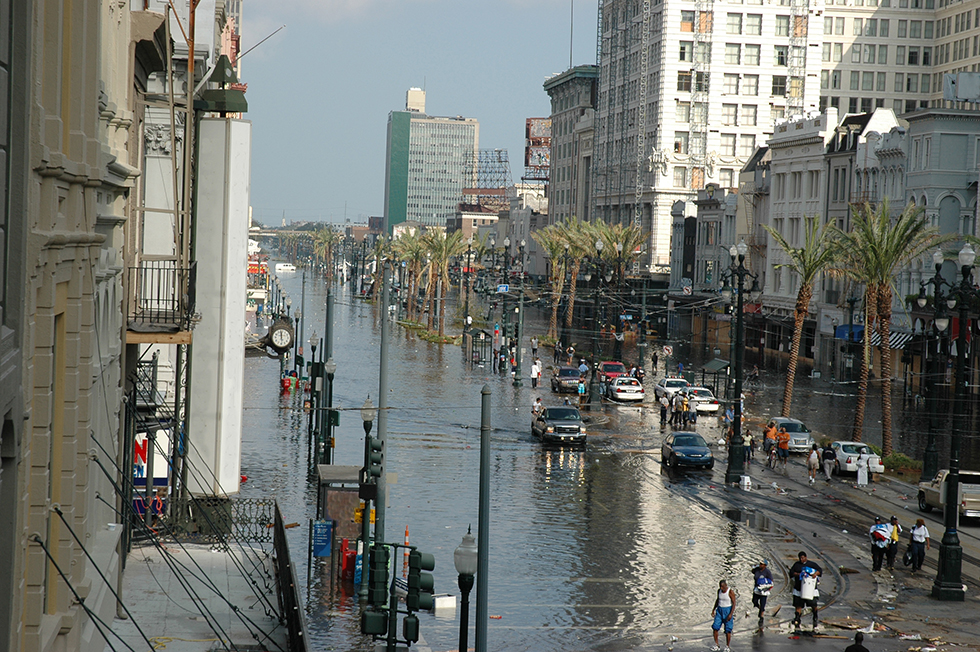Weathering the Storm: A Framework for Meeting CRA Obligations
Part Two: How a Bank’s Activities in Disaster Recovery Can Fit CRA Criteria
 In 2005, Hurricane Katrina devastated New Orleans, exposing many of the city’s structural deficiencies and the unmet needs of its residents.
In 2005, Hurricane Katrina devastated New Orleans, exposing many of the city’s structural deficiencies and the unmet needs of its residents.In the wake of hurricanes Katrina and Rita, federal financial regulators saw an opportunity for banks to better serve the needs of their communities and assessment areas by becoming more involved in the revitalization and stabilization of communities devastated by natural disasters. The final guidance, which took effect in 2005, expanded the definition of “community development” under the CRA to include activities that revitalize or stabilize LMI geographies, distressed or underserved nonmetropolitan middle-income geographies, or designated disaster areas.
The Federal Financial Institutions Examination Council (FFIEC) Interagency Q&A § _.12(g)(4)(ii)—1 explains that a “designated disaster area” is a major disaster area that has been designated as such by the federal government, more specifically FEMA. However, counties designated by FEMA to receive only FEMA Public Assistance Emergency Work Category A, which covers debris removal, and/or Public Assistance Category B, which covers emergency protective measures, are excluded under CRA. As part of the process of issuing major disaster declarations, FEMA publishes notices at www.fema.gov that include information regarding past disaster declarations as well as the process itself.
| Remember the Primary Purpose |
|
To obtain consideration under CRA, every activity a bank engages in must not only fall within one of the four categories listed under the definition of community development, but must also have community development as its primary purpose. According to Federal Financial Institutions Examination Council Interagency Q&A § _.12(h)—8, primary purpose can be demonstrated by one of these methods:
This means that, for a bank to receive CRA consideration for a disaster-recovery-related activity, not only must the activity meet the definition of “revitalizing and stabilizing a designated disaster area,” but the bank must also show either that the majority of the dollars or beneficiaries fall within the definition of community development under CRA or, alternatively, that the intent and structure are for a community development purpose and the activities did or will with reasonable certainty achieve their community development goals. |
Time Constraints
According to Q&A § _.12(g)(4)(ii)—1, banks generally have 36 months following the date of a major disaster declaration by FEMA to engage in institutional activities related to disaster recovery that revitalize and stabilize a FEMA-designated disaster area. This period can be extended by the federal financial regulatory agencies when a clear community need exists to facilitate long-term recovery efforts.
For example, an extension of the 36-month time limit was granted in 2008 following hurricanes Rita and Katrina, and this extension played a major role in aiding the long-term recovery of the Gulf Coast region. Institutions should look to interagency guidance letters following major disaster declarations for such extensions and clarification on coverage areas and terms.
What Activities Count?
For consideration under CRA, banks must engage in activities that “revitalize or stabilize designated disaster areas.” Q&A § _.12(g)(4)(ii)—2 defines revitalization or stabilization activities as:
- Activities related to disaster recovery that help attract new, or retain existing, businesses or residents
- Activities that are consistent with a bona fide government revitalization or stabilization plan or disaster-recovery plan
| Examples of Activities That Revitalize or Stabilize Designated Disaster Areas |
|
Federal Financial Institutions Examination Council Interagency Q&A § __.12(g)(4)(ii)—2 provides examples of activities that qualify under CRA as revitalizing and stabilizing designated disaster areas:
As with all revitalization and stabilization activities under CRA, examiners will look for the direct long-term benefits that an institution’s activities provide to a designated disaster area. Note
|
For the purpose of CRA consideration, Q&A § __.12(g)(4)(iii)—3 details that examiners can consider all disaster-recovery-related activities that revitalize or stabilize a particular designated disaster area, but greater weight will be given to activities that are most responsive to the needs of the community, including the needs of LMI individuals and neighborhoods.
For example, if a bank provided affordable, low-interest home repair disaster loans to homeowners in three census tracts (one upper income, one middle income and one low income) located in a federally designated disaster area within the bank’s assessment area, the examiner during his or her review might consider all the loans as qualified activities—but the loans that benefit LMI tracts or individuals would be considered more responsive.
Banks may look to state, county and city governments for disaster-recovery plans or other bona fide revitalization and stabilization plans for guidance on their disaster-related activities. Many of these plans identify unmet needs within the community as well as areas where investment may be most important. Ensuring that the bank’s activities are aligned with the plans of local government may assist the bank with making certain its efforts are indeed responsive.
School districts and other official local governance boards, such as flood control, municipal utility and county hospital districts, may serve as additional sources of bona fide government plans. These plans may be more focused on particular subject areas such as education and health care or may target special populations, including LMI individuals. Identification of these distinct issues as well as community subgroups can provide banks with opportunities to use New Markets Tax Credits (NMTCs) and other creative financing tools to achieve their disaster-recovery-related activities.
Next: Part Three: Identifying Opportunities Within Disaster Recovery and CRA »